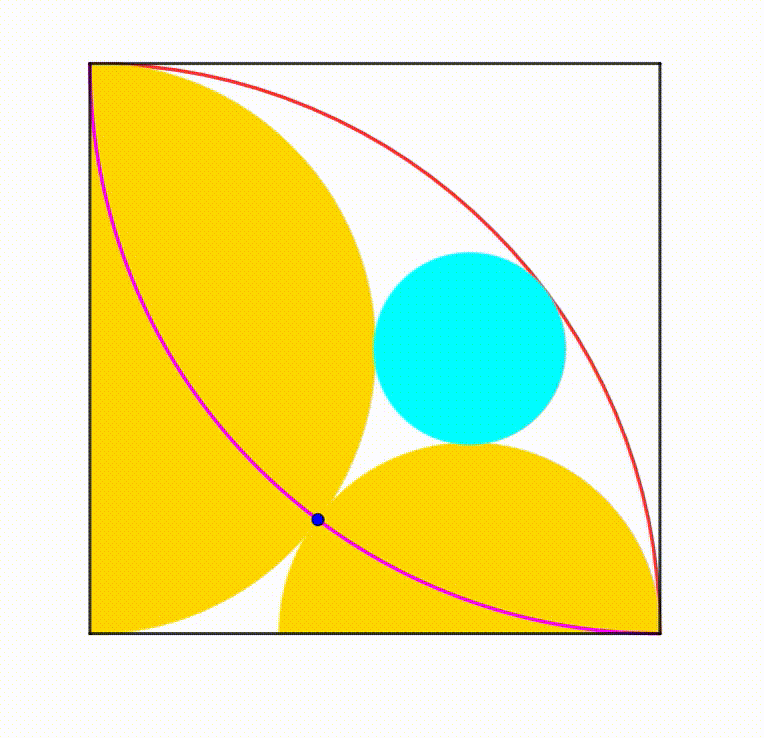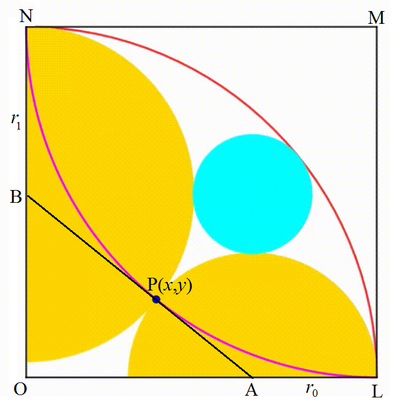Dynamic Geometry: P66
 The diagram shows a unit black square. A red quarter circle is drawn using the side of the square as the radius. Two yellow semicircles are drawn. Each center moves on one square's side so the semicircles are growing, shrinking and are tangent to each other at any moment. The intersection point between the two yellow semicircles traces a
locus
(pink curve). The area bounded by the red quarter circle and the pink curve can be expressed as
a
π
+
b
, where
a
and
b
are integers. Find
a
+
b
.
The diagram shows a unit black square. A red quarter circle is drawn using the side of the square as the radius. Two yellow semicircles are drawn. Each center moves on one square's side so the semicircles are growing, shrinking and are tangent to each other at any moment. The intersection point between the two yellow semicircles traces a
locus
(pink curve). The area bounded by the red quarter circle and the pink curve can be expressed as
a
π
+
b
, where
a
and
b
are integers. Find
a
+
b
.
The answer is 1.
This section requires Javascript.
You are seeing this because something didn't load right. We suggest you, (a) try
refreshing the page, (b) enabling javascript if it is disabled on your browser and,
finally, (c)
loading the
non-javascript version of this page
. We're sorry about the hassle.
2 solutions
Very nice solution, thank you for posting!
Log in to reply
Thanks Valentin! And thank you for the unstoppable production of your dynamic geometry problems.
Log in to reply
Thank you for your appreciation, it means a lot from you.

Label the unit square L M N O , where O ( 0 , 0 ) is the origin of the x y -plane, the centers of the right and left semicircles be A and B respectively, and an arbitrary point on the locus be P ( x , y ) . Let the radii of the two semicircles be r 0 and r 1 as shown. Then
{ A = ( 1 − r 0 , 0 ) B = ( 0 , 1 − r 1 ) ⟹ P ( x , y ) : ⎩ ⎪ ⎨ ⎪ ⎧ x = r 0 + r 1 r 1 ( 1 − r 0 ) y = r 0 + r 1 r 0 ( 1 − r 1 )
By Pythagorean theorem ,
O A 2 + O B 2 ( 1 − r 0 ) 2 + ( 1 − r 1 ) 2 1 − r 0 − r 1 ⟹ r 1 = A B 2 = ( r 0 + r 1 ) 2 = r 0 r 1 = 1 + r 0 1 − r 0
Now consider:
( x − 1 ) 2 + ( y − 1 ) 2 = ( r 0 + r 1 r 1 ( 1 − r 0 ) − 1 ) 2 + ( r 0 + r 1 r 0 ( 1 − r 1 ) − 1 ) 2 = ( r 0 + r 1 − r 0 ( 1 + r 1 ) ) 2 + ( r 0 + r 1 − r 1 ( 1 + r 0 ) ) 2 = ( 1 + r 0 2 ) 2 ( 2 r 0 ) 2 + ( 1 − r 0 2 ) 2 = ( 1 + r 0 2 ) 2 4 r 0 2 + 1 − 2 r 0 2 + r 0 4 = ( 1 + r 0 2 ) 2 ( 1 + r 0 2 ) 2 = 1
This means that the locus is circular quadrant with center ( 1 , 1 ) and radius 1 . Therefore the area bounded by the red quadrant and the locus is twice the area of a 9 0 ∘ circular segment with radius 1 or
2 ( 4 π − 2 1 ) = 2 π − 1
Therefore a + b = 2 − 1 = 1 .
Thank you for posting.
Log in to reply
@Chew-Seong Cheong Tricking you or anyone was not my intention. I hope you will not boycot my problems for now since I always appreciate your solutions and feedback.
Log in to reply
No of course not. Just want to let you know.
Log in to reply
@Chew-Seong Cheong – Ok then. If you found some problems/concept really interesting try to let me know sometimes because then I may try to dig for new ideas in these configurations.
Points K , P and L are collinear, and ∠ A K L = 2 θ , ∠ A L K = 2 φ , thus 2 θ + 2 φ = 1 8 0 ∘ − ∠ K A L = 1 8 0 ∘ − 9 0 ∘ = 9 0 ∘ , hence θ + φ = 4 5 ∘ From this we get that ∠ D P B = 1 8 0 ∘ − ( θ + φ ) = 1 8 0 ∘ − 4 5 ∘ = 1 3 5 ∘ and this implies that P lies on the circle with center B and radius C B = 1 , hence the pink curve is a quarter of this circle.
Finally, the area A bounded by the red and the pink curve is A = A ( A , B D ⌢ ) + A ( C , B D ⌢ ) − [ A B C D ] = 4 π + 4 π − 1 = 2 π − 1 For the answer, a = 2 , b = − 1 , thus a + b = 1 .